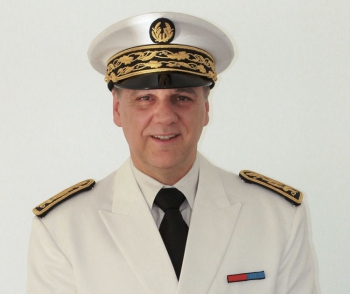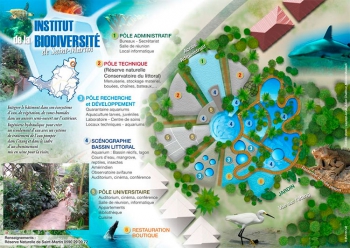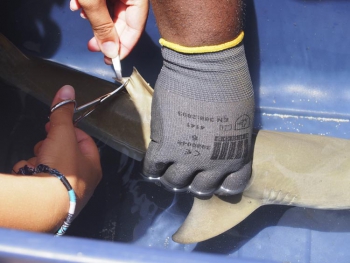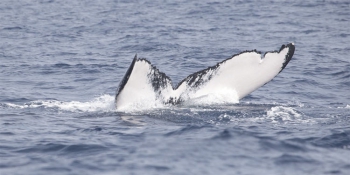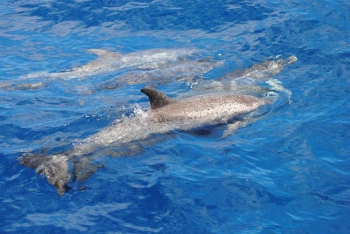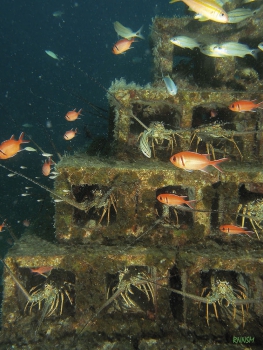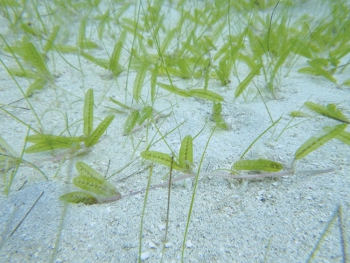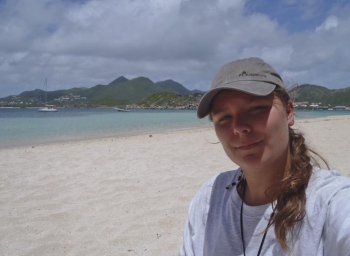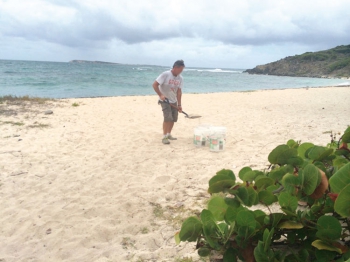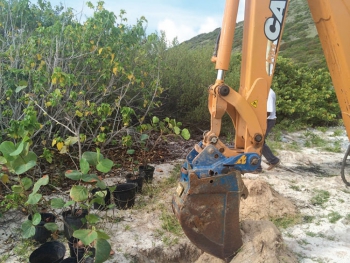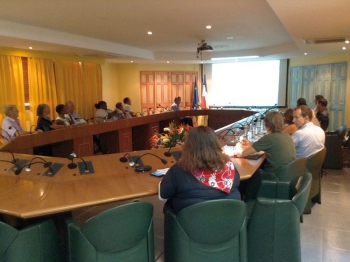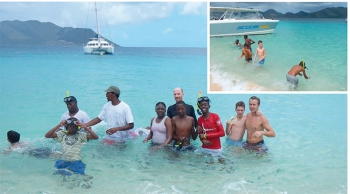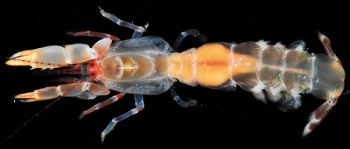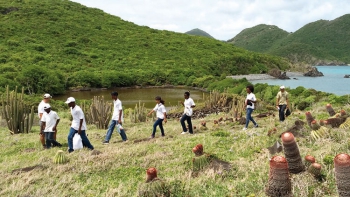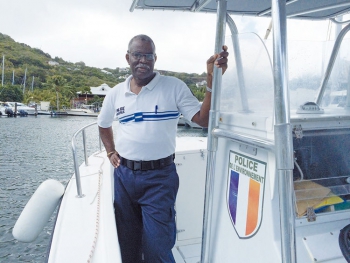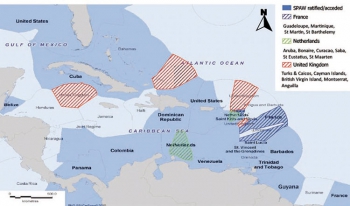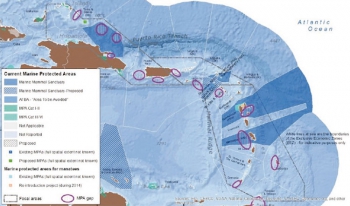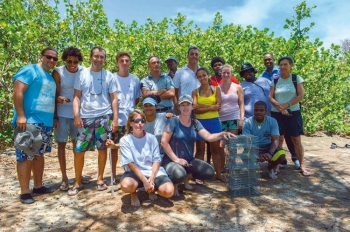The Nature Reserve’s project to create a Marine Biodiversity Institute holds a privileged position in the European Operational Program 2014-2020, and I am very pleased about it. Besides the fact that it will further enhance the environmental protection that is already in place, this new center is an important asset for the creation of new career paths and the promotion of ecotourism on the French side of the island. My team, partners and I have worked together with the Reserve on defining this project in order to dispose of a truly effective tool. The Nature Reserve is doing an excellent job, and the State regularly turns to it for its expertise in environmental matters. Such will be the case for the protection of the Simpson Bay Lagoon, a project of cooperation between the two sides of the island that will also benefit from European funding. Let’s carry on the good work. Saint-Martin’s wealth is the quality of its natural environment which gains in value every day, and we should all take it upon ourselves to improve it.
Newsletter-21
Newsletter-21
Better Knowledge About Protected Areas And Protected Species
It’s official! The Nature Reserve is creating the caribbean Island Biodiversity Institute that will further reinforce their effectiveness in Saint- Martin. This major and innovative project was given the go-ahead at the end of July upon signature of a financing agreement that forms part of the Development Contract existing between the Collectivité and the State. A feasibility study begins in September, but the official inauguration will only take place in 2017 when the establishment is finished being built. This ambitious project will offer a Center for Excellence in research, environment and ecotourism. Its main objective will be to improve knowledge about our island’s different ecosystems, and their potential, by increasing the level of activities carried out by the scientific department at the Reserve, and by increasing exchanges with the universities within the Caribbean and elsewhere. It will be innovative in terms of ecosystem management, create channels for economic development focused on fishing, aquaculture and agriculture, and set up training courses that are related to the environment: ecotourism tour guides (on land and at sea), nature police, marine related professions, optimization of ecotourism projects… The institute will be located on a prime site oriented towards the sea and the salt ponds, in a natural setting that is consistent with the Reserve’s actions. The Reserve will have their offices there, but above all it will be a living museum with a tropical garden, an aquarium, a walkway and even a care center for injured animals. The idea is to teach the public (schools, island residents, tourists) the importance of all the ecosystems on the island. The building itself will blend into its natural environment and preference will be given to the most innovative sustainable building techniques.
5.4 million euros have been allotted to this project under the Collectivité - State Contract Plan. The creation of ten new posts is envisaged and the Reserve plans to auto finance a large part of the operation by opening their doors to the public, having permanent and temporary exhibitions, and an auditorium for the use of conferences.
People are generally scared of sharks. And Saint- Martin is no exception, even although no accident has ever been reported here. However, myth is stronger than reality, especially since the series of shark attacks in Reunion. In order to understand this great cartilaginous fish better and to educate the public with accurate information, the Nature Reserve launched project Negara, as in Negaprion. This is the scientific name for the lemon shark, a species that is commonly found along the beaches and that is most in contact with swimmers. This project was selected by Ifrecor, who financed most of it, and the Reserve provided the service of their human and logistical resources. The mission took place in July with the collaboration of Océane Beaufort, a scientist enriched by the first study she did on the reproductive systems of lemon sharks in Petite-Terre Nature Reserve, and in charge of a shark monitoring network for the association KapNatirel (online at www.reguar.org). Young sharks spend their first two or three years close to the shores to protect themselves against their predators. The mission consisted of locating, luring and then capturing several specimens with the help of a barbless hook. Twelve lemon sharks no bigger than 80 centimeters in length were weighed and measured, and had a skin sample taken to analyze their DNA and to possibly learn more about their origins. Each shark was tagged in the dorsal fin with a numerical and color-coded tag, corresponding to a given site, before being released back into the sea. The data is currently being processed and a report will be published before the end of this year 2014.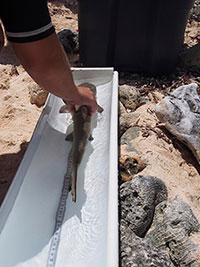
If this study was extended across to other islands it would help improve the knowledge about the behavior of the adults of this species, as almost nothing is known at this time. After this first study on our island, Océane Beaufort noted that the lemon shark population in Saint- Martin is higher than in Petite-Terre, in Guadeloupe, and the same goes for certain other species as well, such as reef sharks and nurse sharks.
As the representative of AGOA Sanctuary in Saint-Martin, the Reserve has an especially soft spot for marine mammals, and conducts annual scientific monitoring programs each year. Since 2003, the Reserve has managed to put together a large portfolio of photographs taken on their field trips out at sea. In amongst these photos are some valuable shots of humpback whales’ dorsal and caudal (tail) fins, which can be used as accurate identification cards for each animal. The idea is to be able to identify an animal visually as it’s moving around, without having to disturb it. Similar catalogues exist elsewhere and have enabled scientists to recognize, by comparing two identical photos, that a specific whale observed in Cape Verde was then seen in Guadeloupe, for example. To improve their knowledge on marine mammals, the Reserve is currently working on a catalog of identification photos taken around Saint-Martin and Sint Maarten. 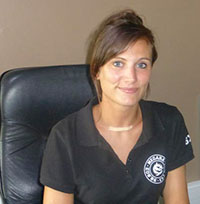 Marion Barrau, a fourth year student from the veterinary university of UAX, in Madrid, spent her summer preparing this catalog that today identifies 35 humpback whales, as well as 25 bottlenose dolphins. These photos were taken by the Reserve team and also by several eco-volunteers and other marine mammal enthusiasts. Marion invites all whale and dolphin lovers to send their photos of caudal or dorsal fins by email to: baleine@rnsm.org. Please note that these photographs will remain the property of the photographer, whose name will appear on each photo used. The Saint-Martin/Sint Maarten catalog will grow over time and become a valuable database that will allow us to track their migration routes, and also teach us more about their abundance and be able to estimate their population. When completed, this catalog should be available online and will allow everyone to participate in the identification of individuals out in the field, to share lucky encounters and to add new photos that will further enrich this database. The Reserve is working in partnership with the Observatoire des mammifères marins de l’arc guadeloupéen (OMMAG) on this project, who have a thick catalog of photos that is available for viewing on ommag.info. A big thank you to OMMAG for their technical support and their passion to communicate!!
Marion Barrau, a fourth year student from the veterinary university of UAX, in Madrid, spent her summer preparing this catalog that today identifies 35 humpback whales, as well as 25 bottlenose dolphins. These photos were taken by the Reserve team and also by several eco-volunteers and other marine mammal enthusiasts. Marion invites all whale and dolphin lovers to send their photos of caudal or dorsal fins by email to: baleine@rnsm.org. Please note that these photographs will remain the property of the photographer, whose name will appear on each photo used. The Saint-Martin/Sint Maarten catalog will grow over time and become a valuable database that will allow us to track their migration routes, and also teach us more about their abundance and be able to estimate their population. When completed, this catalog should be available online and will allow everyone to participate in the identification of individuals out in the field, to share lucky encounters and to add new photos that will further enrich this database. The Reserve is working in partnership with the Observatoire des mammifères marins de l’arc guadeloupéen (OMMAG) on this project, who have a thick catalog of photos that is available for viewing on ommag.info. A big thank you to OMMAG for their technical support and their passion to communicate!!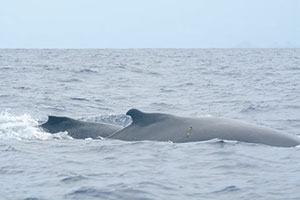
Following Guadeloupe and Martinique, the 2014 Agoa campaign took place in the Îles du Nord. The scientific monitoring of marine mammals in the dry season was successfully carried out from April 15th to 28th. Numerous marine mammals were observed between Saint-Martin, Sint Maarten, Anguilla, St. Barts, Saba and St. Eustatius, including humpback whales, pantropical spotted dolphins and bottlenose dolphins. The Nature Reserve was involved in the program, as usual, along with eco-volunteers from Saint- Martin and Guadeloupe, and Amandine Eynaudi, a manager from Agoa based in Guadeloupe, CAR-SPAW, Anguilla and Saba.
Managing The Impact Of Human Activities In Protected Areas
The pilot project that we spoke of in our last newsletter, an artificial underwater habitat Bio- Hab created to ensure a safe habitat for thousands of larvae to live and reproduce, is already deemed a great success. Since the first module (concrete air-bricks stacked into a pyramid), was put into place in January 2014, 4 other different shaped modules have been constructed and 9 modules in total have been installed. The first monitoring dives revealed a rapid increase of fauna around the first module, followed by almost identical colonization on all the others. In only 5 months, 33 species have settled in this previously uninhabited site. 151 Individuals per 100m2 were counted in July, including 63 Caribbean spiny lobsters, a density per meter squared that is far higher than what we would normally find on natural reefs! Other species most present are blue striped grunts, mombins, arrow crabs and cleaner shrimps. The estimated biomass is 45.1kg per 100m2, of which the Caribbean spiny lobsters make up 43.5kg. Needless to say, the location of this experimental site is kept confidential by the Reserve as it may be regarded by some as a small gold mine. The project will continue moving forward with the establishment of a second site, before the end of 2014, also within the Reserve, but this time in shallower waters. The goal is to compare the types of fish that will colonize these modules, and the logistical constraints related to the depth of the site: dive time, wave impact, light source...
Éva Moisan arrived at the Reserve in February and had six months to study the Halophilia stipulacea, an invasive species introduced through boat anchors that is slowly taking up more and more space on the seagrass beds. The evening before her departure, this professional Masters student from the University of Corte delivered her final report and gave nuanced answers about the consequences of the arrival of these algae in the waters of Saint-Martin. Firstly, this plant is smaller in Saint-Martin than it is in the rest of the Caribbean. Here, its rhizomes grow from 0,26 to 2,16cm per day, whereas a daily growth of up to 6cm was recorded on other Caribbean islands. Her study showed that the algae has a stunted growth on the sites where it is competing with Syringodium and Thalassia, both local species, but that it is rapidly spreading across deeper sand plains that are uninhabited by vegetation. As a measure of precaution, the first observations are pointing towards classifying this plant as a potentially invasive species – taking into account that it continues to spread, it is not regressing on any of the sites where it is already colonized, and after a year, it has appeared on five new sites. It has already been given the status of an invasive species by other islands in the Caribbean. On the other hand, the progress made during this study doesn’t permit an affirmation that this species is necessarily destructive. New studies should be able to clarify conclusions, particularly those concerning Halophilia stipulacea’s interaction with local flora. Note: the plant takes advantage by establishing itself where the native seagrass is most fragile, usually as a result of certain sites having had waste water poured into them, or being victim to destruction by way of boat anchors and their chains.
In order to avoid the destruction of seagrass beds, boats now have to use the mooring buoys that the Nature Reserve has installed at Créole Rock, Pinel and Tintamarre.
Thanks to the work done by Léa Daures, a twenty year old student at the Faculty of Science in Montpellier, the atlas showing all the sites where sea turtles nest is now up to date. Five years ago Pauline Malterre, who at the time was officer-in-charge of the scientific department at the reserve, created this atlas together with Eric Delcroix, who was the manager of the sea turtle network in Guadeloupe. This atlas recapitulates the current state of all the beaches that the turtles return to during nesting season. During her voluntary post-license internship, Léa walked all the concerned beaches in order to record any changes that had taken place in 2014. Basing her report on the existing data, she noted any apparent changes to the beach surfaces; an increase or decrease in vegetation, new buildings, and any other factors that could disturb the turtles when laying their eggs; bright lights or noise, for example. This atlas covers all nesting zones for sea turtles throughout the entire French Antilles, and its regular updating is an additional tool that helps towards their preservation.
The Reserve also protects its sand
On June 6th, a dishonest man was caught in the act of stealing sand from Grand Cayes beach. The quantity of sand stolen was only 3 bucketfuls; the Reserve guards let him off with a warning.
Paying his debt to society by cleaning up a beach
As part of the agreement signed with the prosecutor and children’s judge, the Reserve hosted two persons guilty of minor offenses that had admitted to their crimes, and agreed to perform TNR (travail non rémunéré - unpaid work) for the benefit of the community. This program is different from TIG (travail d’intérêt général – community service), in that the offenders avoid going to court and entering into procedures that are sometimes unsuitable with regards to the gravity of their acts. Their work consisted of cleaning up Grandes Cayes beach, for one day in June for the first offender, and in August for the second.
Restoration Of Degraded Areas And Populations
17 foolproof moorings at Tintamare
Replacing mooring buoys, that are often the objects of damage and theft, is something that the Reserve is all too familiar with and have perfected over time. For example, by early May there were only 3 mooring buoys left at Tintamare, the team has now put in 17 new buoys that are connected to their mooring by a cord made of steel and nylon that should resist both boat propeller blades and attempted theft.
207 trees planted at Grandes Cayes
In late May a trench was dug and 207 trees were planted along the beach at Grandes Cayes (between the road and the beach), in order to stop people parking there. Blocks were also erected between the trees to help reinforce the matter. Preference was given to three local tree species – the catalpa, sea grape and almond trees - and now all that’s needed is a couple of years and then site will be covered in shade. This work was carried out by the Nature Reserve and the Conservatoire du Littoral, along with the voluntary help of the company Verde, who manages the Ecosite, and the company Jardinia.
Environmental Communication And Education
On June 30th, the general assembly of the Management Association of the Nature Reserve was held at the Collectivité, and President Aline Hanson warmly congratulated the Reserve team for the sound information that was transmitted to the elected officials. All actions carried out by the Reserve in 2014 were presented, the 2013 budget was presented and approved, and the 2014 budget was also presented.
Firstly we must remember that the Reserve is now more than 15 years old, and has reached a certain maturity. It is no longer seen as the «troublemaker », as was the case in the beginning. The public appreciates what the Reserve represents, and the benefits that it brings to Saint-Martin, whose main economy is tourism which totally depends on the quality of the environment. On the subject of tourism, the director of the reserve, Nicolas Maslach, stressed that birdwatching is an ecotourism activity that is developing worldwide and that generates approximately $15 billion per year. Saint-Martin, although still fairly unknown for this activity, is an excellent birdwatching destination with large populations of diverse species, very few hunters, birds that are accustomed to human activities (airplanes, construction ...) and can easily be observed. The audience was shown a film about the artificial reef that the Reserve installed (see pages 10 and 11) and was able to visually follow the rapid development of wildlife, particularly the presence of numerous spiny lobsters. After the screening, Christophe Henocq, a member of the association, put forward the idea of installing this type of reef for fishermen outside the Reserve territory. He asked what the cost of such a project would be, and what the expectations were. Nicolas Maslach replied that the cost of installing about 100 modules in an appropriated zone would rise to about 150,000€. He noted that this project was initiated by the Reserve as an act of conservation, but that it could in fact open up new economic opportunities superior to those already in place. He added that thought should be given to an appropriate regulation and to the allocation of the AOT by the administrator, which would need to be defined. After the budget presentation, Bruno Lizé, a chartered accountant, stated that the Nature Reserve’s own resources are now sufficient to finance most of its actions. He added that the development of the Reserve’s financial resources is in line with its steadily growing development and activity, and that the Reserve is at the starting point of new environmental and economic challenges that match its ambitions.
The Reserve is continuing to work together with the school establishments as part of “Environmental Communication and Education” that forms part of their plan of action. The 4th year pilot class studying Tourism at the collège in Quartier d’Orléans was particularly spoiled. After an initial presentation given in class by Romain Renoux and Daniel Lewis, these students were taken on two field trips to further their knowledge and explore the reserve. The first trip that took place on May 23rd between the Barrière salt pond and Froussards Trail, gave them the opportunity to see the salt ponds and the coastal area of their island through new eyes. The second field trip had a definite pre-holiday feel about it as they sailed out on the motorized catamaran, Scoobicat, on June 6th. This excursion was the opportunity for them to admire their island from the sea, to discover the smaller islands of Créole Rock, Tintamare and Pinel, and to be made aware of the tourist interest in these magnificent natural sites. Another class, as part of the educational success program, this time from collège Mont des Accords, was lucky enough to embark on an excursion out to sea with Scoobicat on May 16th. The students visited Créole Rock, then Pinel, and they ended their trip off with a long swim at Baie Blanche beach at Tintamare.
We previously published several amazing photos of the 818 species of crustaceans, echinoderms and mollusks that had been identified in the Reserve waters in April 2012.
In order for the entire public to benefit, the Reserve is organizing a mobile exhibition that consists of fifteen posters and a large triptych summarizing the results of the mission.
The exhibition will be displayed in schools, and also in all sorts of different public places as well as at public events. Note: TeMeUm is funding the project as part of environmental education.
On May 26th, the Reserve guards gave a guided tour to a dozen students enrolled in the ULIS (Unité localisée pour l’inclusion scolaire) class at the collège in Quartier d’Orléans, up to Cactus Place, at the edge of Froussards Trail. The college students were given a general presentation about the ecosystems in the Reserve, and today they all know about the Melocactus intortus - or the «Turks Head” - a protected species that abounds in the dry forest zones.
A taste of the holidays at Galion
Initiated by Adeline Arnaud a teacher at the school, Élie Gibbs, students from two CM1 classes got a little taste of the holidays on June 16th during a field trip out to the site of Galion. As they are accustomed to doing so, the Reserve guards raised the children’s awareness about protecting the natural environment and they gave them a presentation about the ecosystems on the site.
Better Means For Better Missions
After having received the new Territorial Chief of Police, Albert Conner, on March 7th, the Reserve welcomed two more agents from the same police unit, Albert Minville and Franklin Flanders.
Recently commissioned nature police after an internship in Guadeloupe, these two men were required to do an internship at the Nature Reserve in order to become familiar with surveillance missions, arrest techniques and generally with all aspects of policing the environment.
All of which they did with great enthusiasm for a week from June 10th to 17th.
Reinforcement On A Regional
We spoke about project BEST in our last issue, and today it is making great strides. The project was initiated so that the EU could strengthen the sustainable conservation of the unique biodiversity of its 34 overseas territories, particularly its 15 island territories in the Caribbean, whether French, Dutch or British. The idea is to establish an inventory of the biodiversity and its challenges, in terms of conservation, that exist in each of these territories, and to ensure long-term funding, which they often lack today. In cooperation with the IUCN (International Union for Conservation of Nature) and CAR-SPAW (Centre d’activités régional pour les espèces et les espaces spécialement protégés de la Caraïbe), based in Guadeloupe, the Saint-Martin Nature Reserve plays a key role in the project since it is going to coordinate the platform or the “hub”, made up of all these territories. This task was entrusted to Romain Renoux, Head of the Regional Cooperation Department at the Reserve, in collaboration with Amandine Vaslet, an employee at CAR-SPAW, as part of the agreement between the Reserve and this center. Amandine, who completed a PhD at the Université Antilles-Guyane in Guadeloupe on fish ecology in mangroves and in seagrass beds, is being hosted and based at the Reserve for two years, which will run until June 2016. She is now seeking to make contact with local stakeholders on the islands concerned in order to write up a summary analysis about the different ecosystem profiles, and to identify clean-up action priorities for each territory. All work will be done by consulting with the local networks and institutions of each country, and this information will be shared bit by bit as the project advances. Meetings are set up and the final report, written in English, will serve as database for the European Union before launching sustainable actions to preserve its ecological environment in the Caribbean... and before putting any funding forward.
In Saint-Martin, Romain Renoux and Amandine Vaslet gave a presentation of the project to Alex Richards, Head of European Affairs and Regional Cooperation. In Guadeloupe they have already been in contact with the National Park, the Director of the Environment, the Regional Council and the Antilles branch of the Agence des Aires Marines Protégées.
Large marine mammals do not respect borders, and during their long migration across the Caribbean, they travel through protected marine areas where their protection is more or less well assured, or not at all.
Ideally, to improve their protection, we need to ensure the preservation of these large animals between the various territories as they pass through by setting up a harmonized transboundary management scheme.
Thus, the Life Web Project, organized by CAR-SPAW, took place in San Juan from April 23rd to 25th, 2014. It is the United Nations and the government of Puerto Rico’s environmental program, and it brought together experts from numerous regions that are concerned by these large animals. Romain Renoux, who represented Saint-Martin and the Agoa Sanctuary, was elected chairman of the meeting.
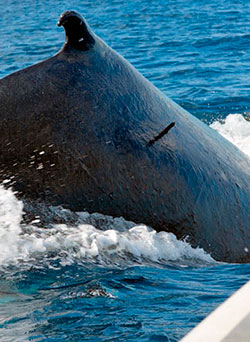 He worked on defining programs for cooperative protection of marine mammals, along with representatives from Trinidad and Tobago, Grenada, Barbados, St. Lucia, Guadeloupe, Antigua and Barbuda, St. Kitts and Nevis, the Netherlands Antilles, the British and American Virgin islands, Puerto Rico, the Dominican Republic, Jamaica and Costa Rica. Boston and Canada were also represented as these large mammals frequent their waters in the summer.
He worked on defining programs for cooperative protection of marine mammals, along with representatives from Trinidad and Tobago, Grenada, Barbados, St. Lucia, Guadeloupe, Antigua and Barbuda, St. Kitts and Nevis, the Netherlands Antilles, the British and American Virgin islands, Puerto Rico, the Dominican Republic, Jamaica and Costa Rica. Boston and Canada were also represented as these large mammals frequent their waters in the summer.
The meeting ended positively, that is to say that the protection of marine mammals is moving in the right direction in the Caribbean, and more and more territories have realized the necessity to preserve them. Specific proposals were made, such as to create sanctuaries or to reduce the impact of human activity (noise, pollution, fishing ...). All that remains today is for the participating nations to turn these proposals into a reality by putting them into action in their territorial waters.
Strategies to manage invasive alien species were the subject of a workshop organized by the Nature Reserve from May 12th to 14th, at the Mercure Hotel. Saba and St. Eustatius Marine Parks attended, along with Petite-Terre Nature Reserve, Bonaire National Park, the Marine and Terrestrial Park of Anguilla, the Minister of Environment from Anguilla, the ONCFS from Guadeloupe, as well as the British Royal Society for the Protection of Birds (RSPB). The first two days were devoted to sharing experiences, with presentations of different actions used to eradicate and control the invasive species found in each territory. Anguilla is the only island to have successfully eradicated all the rats that had invaded Dog Island through implementing a very costly and extensive program of poisoning. They were warmly congratulated by the others as the fight against invasive species is a challenge for everyone. Bonaire, like Saint- Martin (see pages 12 and 13), faces the invasion of the underwater algae Halophilastipulacea. The ONCFS from Guadeloupe, for its part, has had a proliferation of the green iguanas, whilst St. Eustatius is fighting against rats and achatinas that is, of course, when the orchid-loving goats leave them the time to do so!
The third day was spent out in the field at Tintamare where the Reserve gave a demonstration of their method of rodent eradication, which trapped and killed 211 rats and 79 mice in March 2013.

